Authored by Karin Engelhart Jentzsch*,
Abstract
The relative bioavailability of lipophilic nutritional supplements is largely dependent on the delivery system. This is especially true for curcumin, which is extracted from the turmeric root (Curcuma longa L.) and which is becoming increasingly popular due to its antioxidant, anti-inflammatory and other described health protecting properties. In the present study, we present a new technology as delivery system for lipophilic compounds, the Vitaresorp® technology. The technology is based on the use of special phospholipids, which act as carriers for the active components in an oilbased formulation. The technology takes advantage of the ability of phospholipids to spontaneously form micelles in an aqueous environment which naturally occurs during gastro-intestinal passage. The use of plant-based phospholipids supports the rising wishes for sustainable vegan nutrition. In this study, we present comparative data for the transepithelial transport of curcuminoids using the new technology with different phospholipids or powder across the epithelium of the widely used CaCo-2 cell model after an in vitro simulation of the digestion process. The results demonstrate the formation of nanosized particles with improved adherence to intestinal cells and up to 6-fold improved transepithelial transport of curcuminoids compared to powder when delivered with the Vitaresorp® technology. It can be assumed that the principal of this formulation technology can be also applied to other lipophilic plant ingredients with long history of save use, which is mandatory for the use as dietary supplement, or micronutrients with low in vivo bioavailability like iron. Further review of our results on the basis of clinical studies is recommended.
Keywords:Nanoemulsion; Self-assembling; Bioavailability; Caco-2 model; Curcuminoids; Micronutrients; Vitamins
Abbreviations: MTT: Methylthiazolyldiphenyl-Tetrazolium Bromide; MEM: Minimal Essential Medium; FBS: Fetal Bovine Serum; NEA: Non- Essential Amino Acids; PMSF: Phenyl Methyl Sulfonyl Fluorid; TEER: Transepithelial Electrical Resistance; CC: Curcumin; DMCC: Desmethoxy Curcumin; BDMCC: Bisdemethoxy Curcumin; THCC: Tetra Hydro Curcumin; HPLC: High-Performance Liquid Chromatography; UHPLC: Ultra High- Performance Liquid Chromatography
Introduction
The human digestive processes are complex and are mainly driven by the energy status of the organism [1-3]. The uptake capacity of lipophilic and certain hydrophilic micronutrients is limited in the human organism since the transit time of digested food mass in the intestine is short and thus binding and absorption of those micronutrient by the intestinal mucosa restricted [4,5].
It is known that lipophilic nutrients are poorly resorbed in human intestine and that they have to be solubilised by bile salts to form micelles and thus made available for absorption. Furthermore, enzymes produced in saliva, stomach and pancreas are also required for lipid resorption. As a consequence, uptake and resorption of lipids are prone to disturbances and there are multiple causes leading to reduced uptake of fat-soluble food components [4,5]. But not only lipophilic nutrients are susceptible to malabsorption, the uptake of specific micronutrients like iron is also extremely susceptible to disruption. Iron is absorbed for the most part only in the first 30 cm of the small intestine and follows a regulated absorption process [6,7].
A variety of approaches have already been made to improve the absorption of fat-soluble or water-soluble active substances in the human intestine, including the use of micellar nanoparticles [8-10]. However, the use of nanoparticles, especially in nutrition, is often controversially discussed [11], so that there is a need for further research here. The use of phospholipids as carriers has been practiced in the pharmaceutical industry for a long time [8,12], but there are also interesting approaches for food supplements (under patent number EP 3473240, registered on 30.10.2020, a process was described with which, among other things, hard-toabsorb minerals such as iron can be made more available to the organism). At the same time, this opens up the possibility of using such substances in a lower dose with the same or better absorption capacity, so that the burden on the organism is reduced. A plant ingredient that is also poorly absorbable is curcumin which is extracted from the turmeric root (Curcuma longa L). Curcumin has been intensively researched in recent years and is used, among other things, as a plant colouring agent in the food industry but also as a spice ingredient [13]. As a representative of the plant polyphenols, it not only has a colouring character, but has also proven to have antioxidant and anti-inflammatory properties [14- 17], which makes it interesting not only for the pharmaceutical industry, but also for food supplements. However, curcumin is not water-soluble and only fat-soluble to a limited extent and is therefore characterised by poor bioavailability. Recently, numerous methods have been used to improve the bioavailability of curcumin, from the addition of piperine to emulsification with the help of polysorbates to liposomal encapsulation of the substance [18-20].
The technology presented here is based on the use of special phospholipids from various plant or animal sources, which act as carriers for the active components in an oil-based formulation. The technology takes advantage of the ability of phospholipids to form micelles (tiny spherical aggregates with a hydrophilic shell and a lipophilic interior) in an aqueous environment. This takes place during digest process in the gastro-intestinal tract so that the formulation itself does not contain nanoparticles.
The basis of the new technology is the targeted use of shear forces and temperature in certain ratios and specific durations, as well as the processing in the absence of air. Thus, improved bioavailability can be achieved through the attachment of the active components to the binding sites of the phospholipids. This combination of phospholipids in oily suspension and active components then forms micelles or liposomes when released in the aqueous milieu in the stomach and small intestine. Due to their structural similarity to the transport cells of fat digestion (including the chylomicrons, whose building blocks are phospholipids and cholesterol), these micelles or liposomes can promote attachment to the intestinal wall and release into the tissue. Thanks to the oilbased formulation and the biochemical reaction in the digestive tract, the presence of bile acids (which act as emulsifiers mandatory for the digestion of dietary fats) is not mandatory for the formation of micelles.
In order to promote the mode of action of this new formulation technique, we investigated the transport of curcuminoids across an epithelial layer in a widely used CaCo-2 cell model after an in vitro simulation of the digestion process. Transepithelial transport efficacy was compared between a commercial powdered curcumin extract and curcumin processed with the new formulation on basis of krill oil as well as on basis of sunflower lecithin.
Materials and Methods
Chemicals and cell line
Curcuma powder was obtained from Chem2Market (Hamburg, Germany); ascorbyl palmitate was obtained from BTSA (Madrid, Spain). Capsules containing a curcuminoid-ascorbyl palmitate formulation were provided by Qineva (Schwarzenfeld, Germany). Mucin, trypsin, pepsin, bile extract, pancreatin, methylthiazolyldiphenyl-tetrazolium bromide (MTT) and all other chemicals were purchased from Sigma Aldrich (Deisenhofen, Germany). Minimal essential medium (MEM), fetal bovine serum (FBS), non-essential amino acids (NEA), penicillin/streptomycin and trypsin/EDTA solution were obtained from PAN Biotech (Aidenbach, Germany). Caco-2 cells (ATCC® HTB-37™), a human colon adenocarcinoma cell line, were purchased from the American Type Culture Collection (Manassas, USA).
Cell culture
Caco-2 cells were maintained as described by cell provider. Culture medium was composed of MEM supplemented with 20% fetal bovine serum, 1% NEA, 100 U/mL penicillin, and 100 μg/mL streptomycin. For propagation, cells were cultured in an incubator under normal conditions (37°C, 5% CO2) until 80% confluency. Culture medium was changed twice a week. For subcultivation, the cells were harvested using trypsin/EDTA solution and cells were seeded in cell culture treated petri dishes at a density of 1x104 cells/cm2.
Formulation of lipophilic ingredients
Curcumin and ascorbyl palmitate were formulated using the proprietary brand formulation (Vitaresorp®) containing phospholipids from krill oil or sunflower lecithin and packed into capsules. One Curcumin + ascorbyl palmitate capsule (520 mg) contains: 60 mg curcumin in krill oil plus 60 mg ascorbyl palmitate or 100 mg curcumin in sunflower lecithin plus 60 mg ascorbyl palmitate.
Performance of the in vitro tests
In vitro digest
Since it is known that plant ingredients are prone to metabolism during gastro-intestinal passage and that this metabolism is sometimes necessary to reveal physiologically active metabolites, curcumin powder and capsules underwent a simulation of gastrointestinal processes mimicking enzymatic conditions and changes in pH during gastro-intestinal transit. Potential metabolic changes of the test product can thus be recorded and are more related to the in vivo situation.
For better comparison of the test products, curcumin concentration was standardized to 100 mg curcumin/120 mL digest solution. Therefore, the appropriate amount of capsule content or powder were added to 120 mL of an aqueous mucin-pepsin solution with a pH of 2.0, representing one meal. The solutions were incubated for 2 hours at 37˚C with constant agitation. Thereafter, condition was changed to intestinal conditions by adding trypsin, pancreatin, and bile salts and the pH was adjusted to pH 7.5. The solutions were incubated for a further 4 hours at 37˚C with constant agitation. At the end of this incubation period proteinase inhibitor cocktail and PMSF were added in order to inactivate the digestive enzymes. A digest solution without test product was processed in parallel to serve as digest control solution. All obtained digest solutions were then further diluted using culture medium to obtain appropriate concentrations for the bioavailability assay on Caco-2 intestinal epithelial models as indicated in the experiments.
Cell viability
The working concentrations of the digest solutions used in the transepithelial transport experiments were determined prior to the start of the main experiment on the basis of their effect on cell viability. Caco-2 cells were incubated with five different concentrations of each obtained digest solution (6,3 - 100%) for 4 h. The viability was assessed thereafter by means of the resazurin (7-Hydroxy-3H-phenoxazin-3-one 10-oxide) to resorufin (7-Hydroxy-3H-phenoxazin-3-one) conversion assay by aerobic respiration of metabolically active cells and fluorescence measurement at 560nm ex/ 590nm em.
Caco-2 model for trans epithelial transport
For the studies concerning the transport of curcuminoids and ascorbic acid through Caco-2 epithelium, the Caco-2 cells were seeded on ThinCertTM filter membrane inserts (Greiner Bioone, Germany) with 3μm pore size in a density of 0,5 x 105/well. Cells were differentiated to polarised cells over a period of two to three weeks. The degree of differentiation was checked regularly by means of measurements of transepithelial electrical resistance (TEER) using an EVOM epithelial volt/ohm meter (WPI, USA). The models were considered differentiated at resistance of >300Ω.cm2.
To examine the transport rate of the different curcuminoids and ascorbic acid, differentiated Caco-2 models were supplemented with digest solution of each test product (20%, 10%, 5%) for 4 h. Unsupplemented models and supplementation with control digest solution served as controls. After the incubation period, samples were taken from the basolateral compartment and stored at -20°C until analysis of curcumin (CC), desmethoxycurcumin (DMCC), bisdemethoxycurcumin (BDMCC), and tetrahydro curcumin (THCC) content.
Analytics
Medium samples (300 μL) were analysed for CC, DMCC, BDMCC, and THCC using HPLC method as described elsewhere (21). Shortly, medium samples were added to 0.1 % formic acid in acetonitrile (1:1) and centrifuged at 24 °C for 5 minutes at 12000xg after extensive mixing. Analysis took place via LC-MS/MS (Waters XEVO TQS-micro, Waters Cooperation, Milford MA, USA) in positive MRM mode for THCC and by UV-DAD (Acquity eLambda PDA, Waters cooperation, Milford MA, USA) for CC, DMCC and BDMCC. Separation was accomplished on a Waters Acquity H-Class UHPLC equipped with a Waters BEH C18 column (1.7μm, 2.1 x 50 mm) and an isocratic flow of 0.5 ml/min of 55% formic acid (0.1%) and 45% acetonitrile.
Total ascorbic acid was analysed using an RP-HPLC (Waters 717+ Autosampler, Waters 515 HPLC Pump, Waters cooperation, Milford MA, USA) method accredited at BioTeSys GmbH according to DIN EN ISO/IEC 17025 with isocratic elution and coulometric detection (ESA Coulochem II, ESA Biosciences, Chelmsford MA, USA).
Statistics
All experiments were performed twice independently with triplicates each. Data are shown as mean ± SD. Statistical analysis was carried out by a one-way analysis of variance (ANOVA) followed by Dunnett’s multiple comparisons procedure. Statistical calculations were performed using the software package GraphPad Prism (version 5.04, GraphPad Software, Inc.). A p-value <0.05 was considered as statistically significant.
Calculation of the Apparent Permeability Coefficient
Transepithelial transport efficiency of the test compounds from the apical to basolateral compartment was compared by calculation of apparent permeability coefficient (Papp) according to Gebhardt (21): In the present setting, the volume of the apical compartment (VA) is 2 mL, surface area of the porous membrane (Area) is 4,52 cm2, incubation time is 14400 sec. The concentrations of the test compound at the end of the experiment in the basolateral compartment ([drug]acceptor), and initial concentration of test compound applied on the apical side at the beginning ([drug]initial, donor) were analysed as described.
Result
In order to show the efficacy of the new formulation technique, we investigated the degree of absorption of poorly water-soluble curcuminoids and ascorbyl palmitate dissolved in phospholipids of plant and animal sources with the Vitaresorp® technology in a Caco-2 model. The correlation of results obtained in Caco-2 cells and in vivo data are well established and thus this model is widely used to investigate the transepithelial transport through intestinal mucosal epithelial for orally administered ingredients [22]. In order to determine the influence of enzymatic and pH changes on the metabolism and stability of the product during gastro-intestinal tract passage, we simulated the enzymatic and pH changes in vitro before administering the solutions on top of the Caco-2 models.
Particle formation
The basal curcumin and ascorbyl palmitate Vitaresorp® formulation contains phospholipids from instead and krill oil or sunflower lecithin and is thus practically anhydrous. The formation of micelles occurs after the content has been dissolved as a result of the processes in the gastro-intestinal tract. Figures 1 and 2 show the particle size distribution of curcumin in sunflower lecithin or krill oil after solubilisation. Mean particle size in sunflower lecithin is 98.8 nm and in krill oil 45 nm (Figure 1,2).

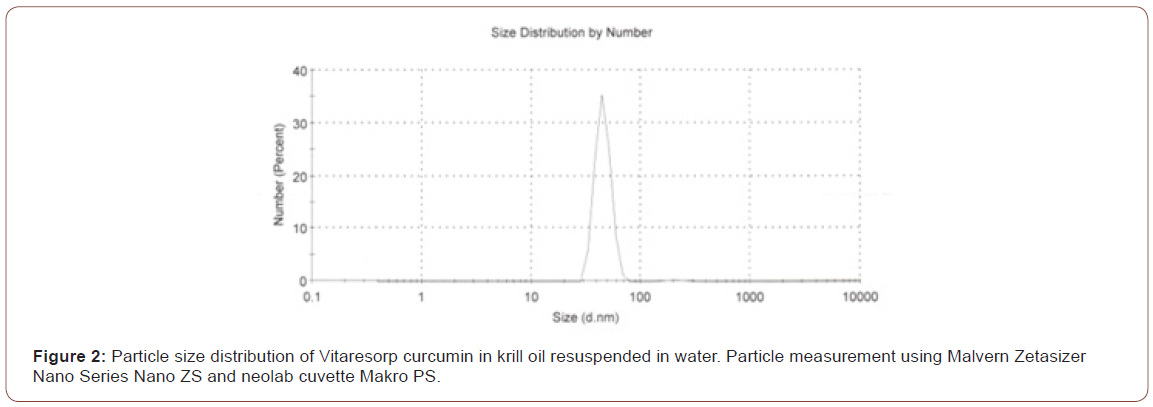
Cell viability
Before starting transepithelial transport testing, Caco-2 viability under supplementation with digest solution of curcumin + ascorbyl palmitate powder or capsule content was assessed after a 4 h exposure. Viability was assessed for four concentrations between 50% and 6.25% digest in medium using resazurin assay. Control digest without active ingredient did not influence the cell viability. However, 50% digest of curcumin + ascorbyl palmitate preparations reduced cell viability almost completely in all test groups. Viability in Caco-2 cultures treated with 25% digest of capsule contents was also <75% of control. (Figure 3). Based on these results, test concentrations for transepithelial transport testing were set to 15% digest solution of each test compound in medium (Figure 3).
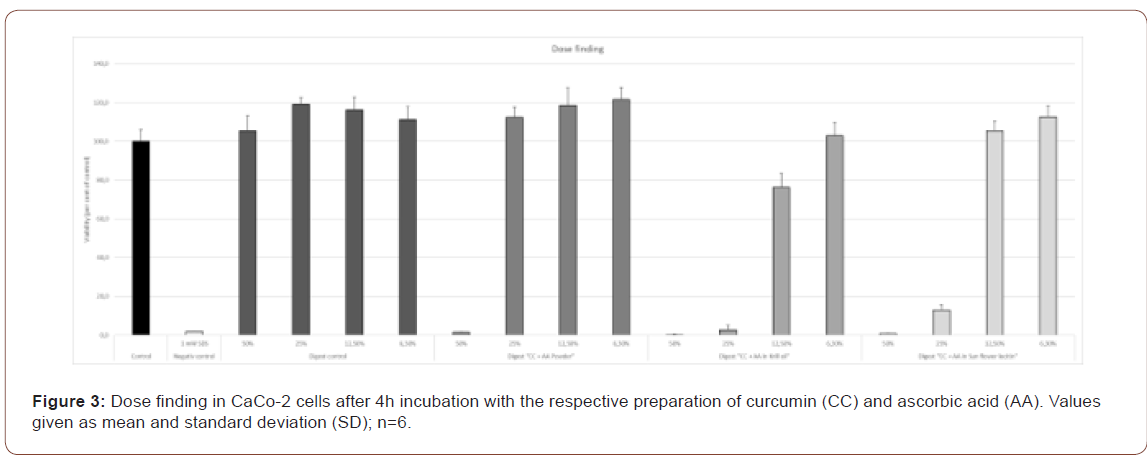
Transepithelial transport
• Total curcuminoid and ascorbic acid concentration in the supplementation medium of the apical compartment was determined at the beginning of the experiment.
• Total ascorbic acid concentration was 4.0 μM in krill oil formulation group, 2.9 μM in sunflower lecithin formulation group and 6.9 μM in the powder group.
• Total curcuminoid concentration was 73.7 μg/mL in krill oil formulation group, 26.5 μg/mL in sunflower lecithin formulation group and 57.3 μg/mL in the powder group.
• Thus, losses of total curcuminoids after digest process was seen in each group and was most prominent in sunflower lecithin formulation group.
• No curcuminoid or ascorbic acid content was detectable in the control digest solution and the cell culture medium.
Curcuminoid profile was investigated in the supplementation medium before starting the transport study. Main curcuminoid in all test solutions was CC with 77.7% of all curcuminoids in krill oil formulation, 74.3% in sunflower lecithin formulation and 77.3% in the powder. DMCC content was between 15.9% and 16.5% and BDMCC was 5.7% in krill oil formulation, 9.8% in sunflower lecithin formulation and 6.2% in the powder. However, we also detected small amounts of THCC in all curcumin containing groups which might be due to redox reactions with ascorbyl palmitat (Table 1).
Table 1: Curcuminoid proportion in supplementation medium. Tetrahydro curcumin (THCC), curcumin (CC), demethoxycurcumin (DMCC), bisdemethoxycurcumin (BDMCC); n.d. = not detectable. Mean and standard deviation (SD); n=2.

Transepithelial transport testing, Caco-2 viability under supplementation of curcumin and ascorbyl palmitat containing digest solutions was assessed after a 4 h exposure. Transepithelial transport of curcuminoids was elevated by the new formulation compared to the curcumin powder. In addition, a metabolization shift towards BDMCC and THCC was observed. In the basolateral medium the curcuminoid proportion was approx. 54% BDMCC, approx. 22% CC, 12-17% DMCC and 7-9% THCC (Figure 4).
In order to compare the efficacy of the transepithelial transport of curcuminoids through the Caco-2 models, the apparent permeability coefficient Papp was calculated. As shown in figure 4, transepithelial transport of total curcuminoids was significantly higher in cultures supplemented with curcumin packed in the new technology than in powder. The Papp for total curcuminoids out of sunflower lecithin was 6-fold and out of krill oil 3-fold compared to powder. However, there is also a significant difference within the new technology with respect to the used lipid. Papp for sunflower lecithin is significantly higher than for krill oil (Figure 5).
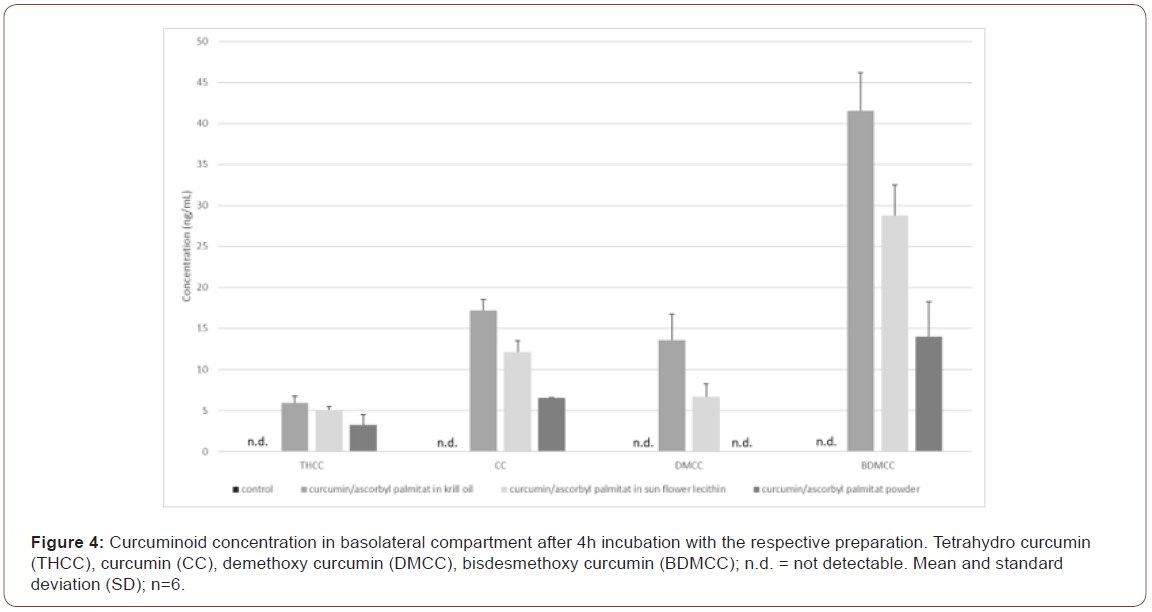
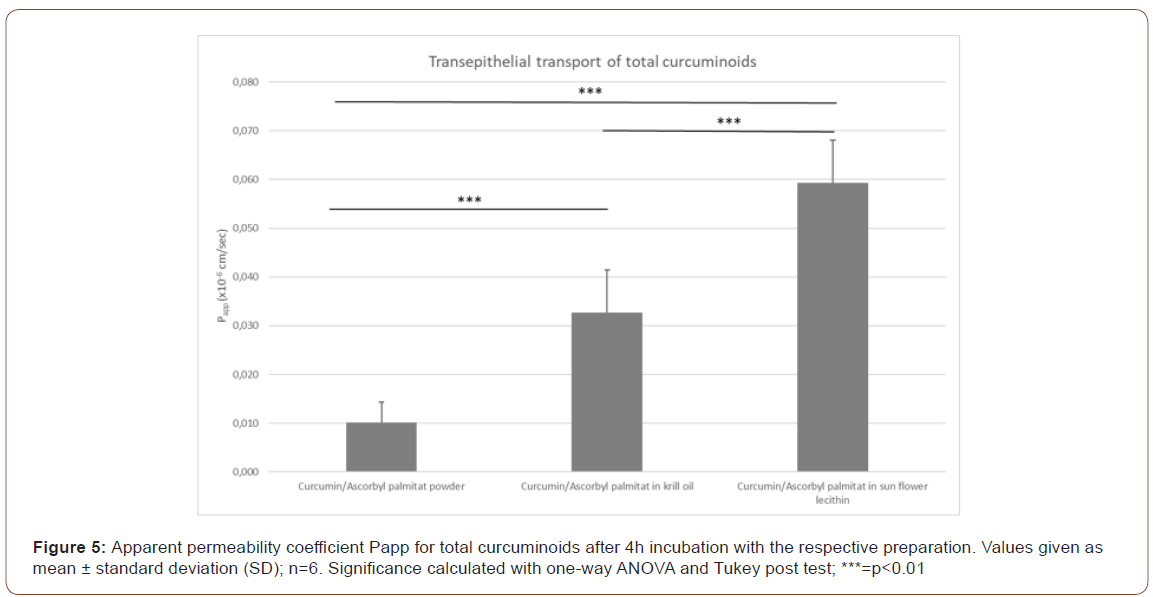
Table 2: Apparent permeability coefficient Papp. of curcumin (CC), dimethoxycurcumin (DMCC), bisdemethoxycurcumin (BDMCC). Values given as mean (n=6).

The new technology was specially designed for the transport of lipophilic substances. However, additives might be included as for stability or protection purposes. In our study, ascorbyl palmitate was added for protection purposes. As seen in figure 6 ascorbic acid concentration in the basolateral compartment was highest in the powder group. Yet, the new technology did not lead to significant differences in transepithelial transport of ascorbic acid (Figure 6).
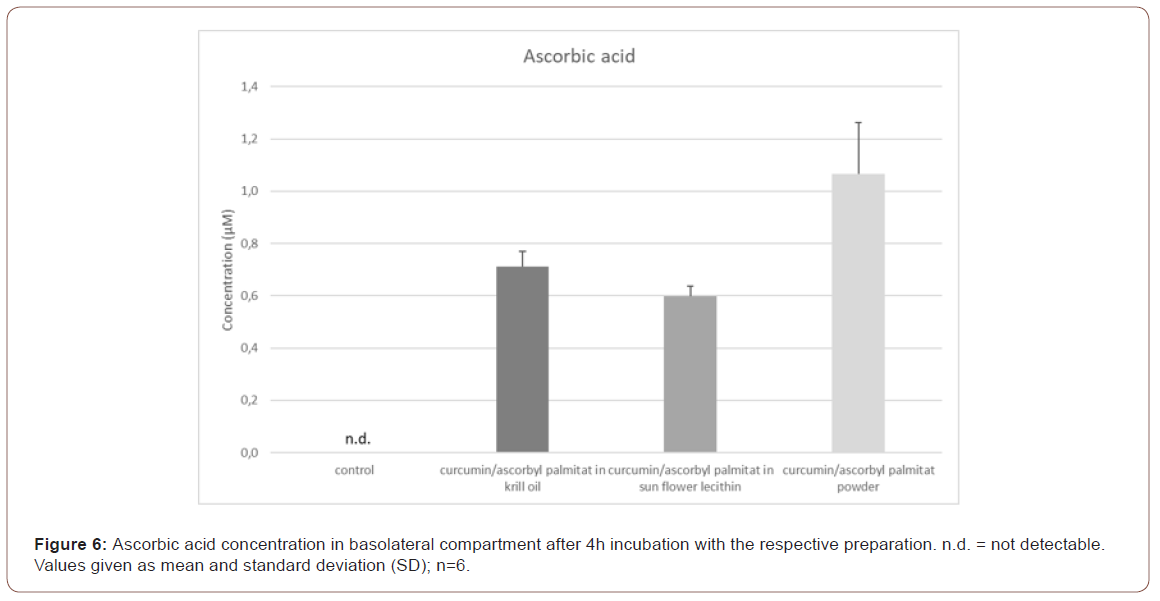
However, when regarding the Papp values, the formulation did not hinder the transepithelial transport of the water-soluble form ascorbic acid as shown in Papp values comparable or even slightly higher than those of the powder (Table 3).
Table 3: Apparent permeability coefficient Papp for ascorbic acid Papp Krill oil.

Discussion
The aim of this project was to evaluate the efficacy of a new formulation technique for lipophilic food ingredients like curcumin. An increased popularity in the use of dietary supplements is seen over the last decades especially for natural products like curcumin containing turmeric powder. Turmeric powder raised special interest since the main polyphenolic ingredients curcumin, demethoxycurcumin and bisdemethoxycurcumin are reported to possess a lot of health beneficial properties like antioxidant and anti-inflammatory [14,23-25]. The poor water solubility and the resulting poor bioavailability [26] led to a variety of formulations including nanoparticles, liposomes, micelles and the addition of piperine [9,22,27-31]. However, those formulations are controversially discussed for dietary supplements [11,19].
It could be shown that after ingestion of the formulation, due to the phospholipids present in high amounts in krill oil, a spontaneous formation of smallest particles phospholipids already occurs in the aqueous environment of the stomach. The diameter of these liposomes is around 50 nm. These smallest particles quickly bind to the cells of the small intestine, where they are broken down by special enzymes and can release their incorporated lipophilic substances such as curcumin.
For a better simulation of the in vivo situation the different formulations and the powder have been subjected to an in vitro digest process prior to the supplementation to Caco-2 cells. This takes into account the assessment of the stability and possible metabolism during enzymatic and pH changes during gastrointestinal passage. The data obtained after this process demonstrate good stability of the curcuminoids but also the metabolic degradation in minor parts to THCC. Degradation of CC to THCC normally occurs by intracellular processes [32] only. In vivo data obtained in mice show that curcumin administered i.p. was first biotransformed to dihydrocurcumin and THC and its glucuronosides [33]. Since this metabolic change to THCC is seen for all three formulations, we assume that it is due to the concurrant presence of ascorbyl palmitate and subsequent redoxreactions.
In the Caco-2 model, representing the intestinal barrier, our data demonstrate a 3.3-fold and 5.9-fold improved transepithelial transport of total curcuminoids across the Caco-2 epithelium of both formulations compared to the powder. This is in accordance with data reported for micellar formulations [34] or liquid formulations [21] also found in Caco-2 cultures and is also in the range of the results Jaeger et al. demonstrated in vivo using a watersoluble formulation containing hydrophilic carrier system [35].
The major benefit of the presented Vitaresorp® technology first of all is that the formulation itself is practically anhydrous and therefore microbiologically stable and secondly the formation of micelles only results in the stomach and the small intenstine after the capsule has been dissolved, which means that it is initially a fat-based formulation without the presence of nanoparticles. In addition, additives such as piperine or synthetic emulsifiers such as polysorbates, some of which are used in comparable products, can be completely dispensed with. Thanks to the special formulation, the product is not to be classified as a novel food and can therefore function as a dietary supplement without hesitation, as the production of the small particles, the micelles, only occurs after oral ingestion through the natural processes in the gastrointestinal tract. The use of natural ingredients and the avoidance of any kind of auxiliary substances has a supporting effect, because the organism is not burdened more than necessary.
Krill oil was approved as a novel food ingredient in the European Community in 2009 [36] and is since often used in dietary supplements due to its demonstrated health benefits [37,38]. Krill oil shows a diverse profile of lipid classes and mainly contains phospholipids, triacylglycerols, diacylglycerols, monoacylglycerols, and valuable omega-3 polyunsaturated free fatty acids. Cholinecontaining phospholipids are the major phospholipids in krill oil [39,40]. Sunflower lecithin is a cheap and plant-based alternative for liposome-based delivery system and proved to be valuable in curcumin loaded liposomes [41]. In the present study, we demonstrated that both systems can be used in Vitaresorp® technology and yield stable curcumin loaded nano emulsions after disintegration of the capsule and introduction into the aqueous environment of the simulated intestinal passage. Though there was a greater loss in total curcuminoids during the gastrointestinal passage processes the plant-based sunflower lecithin was even superior with respect to the transepithelial transport rate.
The major curcuminoid found in the basolateral compartment was BDMCC, a more potent analogue in many in vitro antiinflammatory assays [15,42,43], and not CC. This was also found by Cuomo et al in a randomized, double-blind, crossover human study using lecithin based curcuminoid formulation Meriva [44]. The finding found in this in vitro assay of improved absorption of curcuminoids and metabolism pattern resembling very close to in vivo situation underlines the benefits of the Vitaresorp® technology.
Conclusion
The present data can be considered as an initial proof of concept, providing first results on the beneficial effect of the new formulation on bioavailability of lipophilic micronutrients. The results presented demonstrated that phospholipids present in a liquid formulation are able to spontaneously form a stable nano emulsion incorporating the hydrophobic curcuminoids in the gastrointestinal environment and thus increases the transport across the Caco-2 epithelium compared to undissolved curcumin powder. It can be assumed that the principal of this formulation technology can be also applied to other lipophilic plant ingredients or micronutrients with low in vivo bioavailability like iron. All compounds used are of natural origin and with long history of save use which is mandatory for the use as dietary supplement. The use of sunflower lecithin further supports the rising wishes for sustainable vegan nutrition. However, further investigations on the mechanism and confirmation in vivo are required.
To read more about this article....Open access Journal of Biomedical Engineering & Biotechnology
Please follow the URL to access more information about this article
To know more about our Journals...Iris Publishers





No comments:
Post a Comment